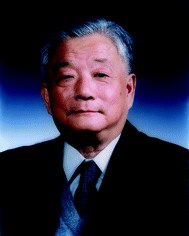Profile of Xi-Yan Lu
State Key Laboratory of Organometallic Chemistry, Shanghai Institute of Organic Chemistry, Chinese Academy of Sciences, China. E-mail: xylu@mail.sioc.ac.cn
What led you to the field of OMCOS?
In the 60s, I worked in the field of synthetic organic chemistry. At the beginning of the 80s, I had the chance to attend the China–Japan–American Symposium on Organometallic Chemistry four times, as well as the OMCOS-2 in Dijon, France. Most importantly, my visits to the laboratories of Prof. Akio in Japan, Prof. Henri Kagan in Paris, France and Prof. G. P. Chiusoli in Parma, Italy influenced me very much, making me realize that organometallic chemistry is closely related to synthetic organic chemistry, and it provides many new possibilities for the development of classical organic chemistry.Besides organometallic chemistry, you have also developed many interesting organocatalyzed reactions, such as phosphine-catalyzed reactions.
Yes, we developed some phosphine catalyzed reactions which attract the interest of chemists. This reaction was discovered by accident in 1991 from the research on palladium–phosphine complex catalyzed isomerization of electron-deficient alkynes. We surprisingly found out that, without the addition of transition metals, the reactions could still be catalyzed by the phosphine ligand(s) alone, giving conjugated electron-deficient 1,3-alkadienes in excellent yields. This led us to fruitful observations on phosphine-catalyzed [3 + 2] cycloadditions of electron-deficient allenes, alkynes or allylic ylides. As was stated in the Account Review article on this subject by our group, “with the understanding of the properties of the phosphine, this may open up broad possibilities for its utilization in organic synthesis”.1Do you mind sharing your motto with us?
I believe the proverb “Necessity will appear as serendipity”. As a scientist, it is important to have sharp eyes to catch phenomena that appear as serendipity, which might lead to a chance of discovering the necessity.Would you like to give some suggestions to those new to science?
I am used to instilling in my students the idea “I want to do this work, rather than being forced by my supervisor”. I believe initiative in doing research is very important.What is your hobby?
My native town is Suzhou. I like the song Suzhou Ping tan ( ). Ping tan is an entertaining way to tell stories about historical events. It teaches how to explain things clearly with concise words, which has largely improved my teaching skills.
). Ping tan is an entertaining way to tell stories about historical events. It teaches how to explain things clearly with concise words, which has largely improved my teaching skills.
Publication highlights
Q.-H. Zhang and X.-Y. Lu, Highly Enantioselective Palladium(II)-Catalyzed Cyclization of (Z)-4′-Acetoxy-2′-butenyl 2-Alkynoates: An Efficient Synthesis of Optically Active γ-Butyrolactones, J. Am. Chem. Soc., 2000, 122, 7604–7605.Y.-S. Du, X.-Y. Lu and C.-M. Zhang, A Catalytic Carbon–Phosphorus Ylide Reaction: Phosphane-Catalyzed Annulation of Allylic Compounds with Electron-Deficient Alkenes, Angew. Chem., Int. Ed., 2003, 42, 1035–1037.
G.-X. Liu and X.-Y. Lu, Cationic Palladium Complex Catalyzed Highly Enantioselective Intramolecular Addition of Arylboronic Acids to Ketones. A Convenient Synthesis of Optically Active Cycloalkanols, J. Am. Chem. Soc., 2006, 128, 16504–16505.
G.-X. Liu, Y.-Y. Shen, Z. Zhou and X.-Y. Lu, Rhodium(III)-Catalyzed Redox-Neutral Coupling of N-Phenoxyacetamides and Alkynes with Tunable Selectivity, Angew. Chem., Int. Ed., 2013, 52, 6033–6037.
Z. Zhou, G.-X. Liu, Y.-Y. Shen and X.Y. Lu, Synthesis of benzofurans via ruthenium-catalyzed redox-neutral C–H functionalization and reaction with alkynes under mild conditions, Org. Chem. Front., 2014, 1, 1161–1165.
K. Shen, X.-L. Han, G.-Q. Xia and X.-Y. Lu, Cationic Pd(II)-catalyzed cyclization of N-tosyl-aniline tethered alkynyl ketones initiated by hydropalladation of alkynes: a facile way to 1,2-dihydro or 1,2,3,4-tetrahydroquinoline derivatives, Org. Chem. Front., 2015, 2, 145–149.
Notes and references
| This journal is © the Partner Organisations 2015 |

